人教版七年级下册unit 8 单元复习知识点课件(共34张PPT)
文档属性
| 名称 | 人教版七年级下册unit 8 单元复习知识点课件(共34张PPT) | 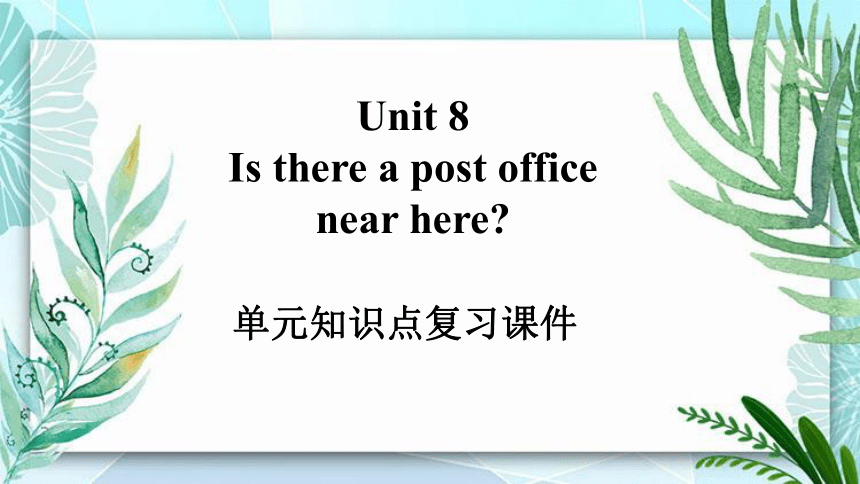 | |
| 格式 | pptx | ||
| 文件大小 | 364.6KB | ||
| 资源类型 | 教案 | ||
| 版本资源 | 人教新目标(Go for it)版 | ||
| 科目 | 英语 | ||
| 更新时间 | 2023-06-11 11:21:09 | ||
图片预览

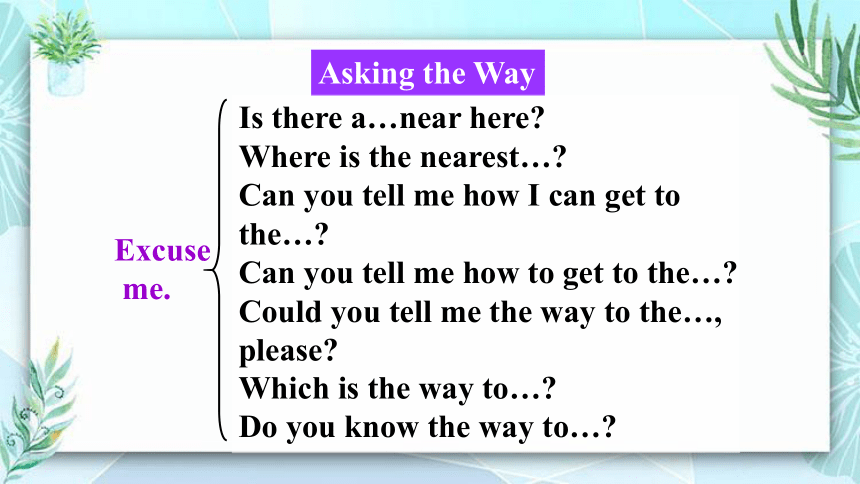

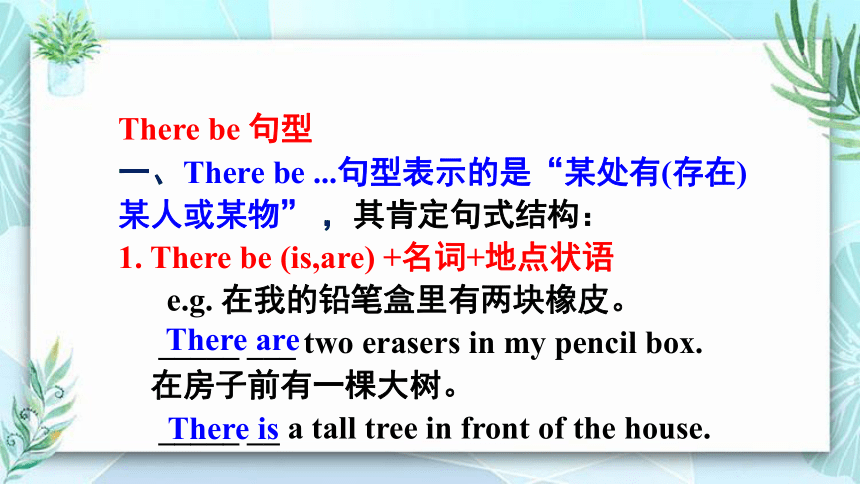
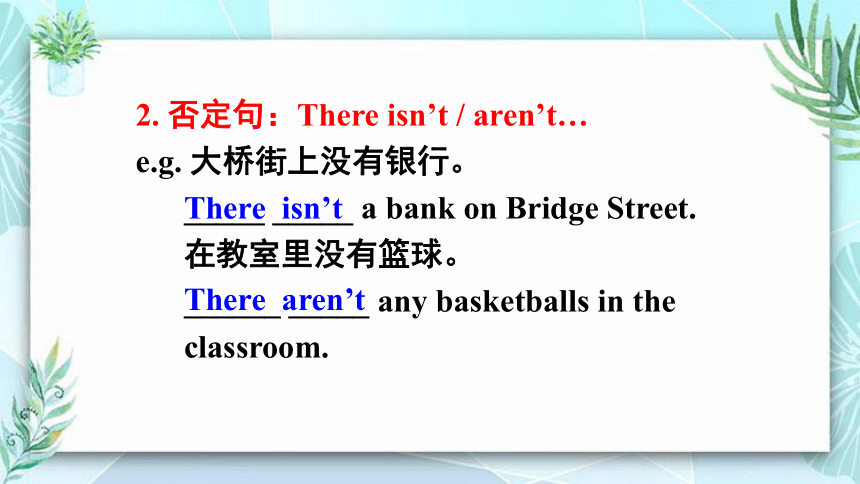
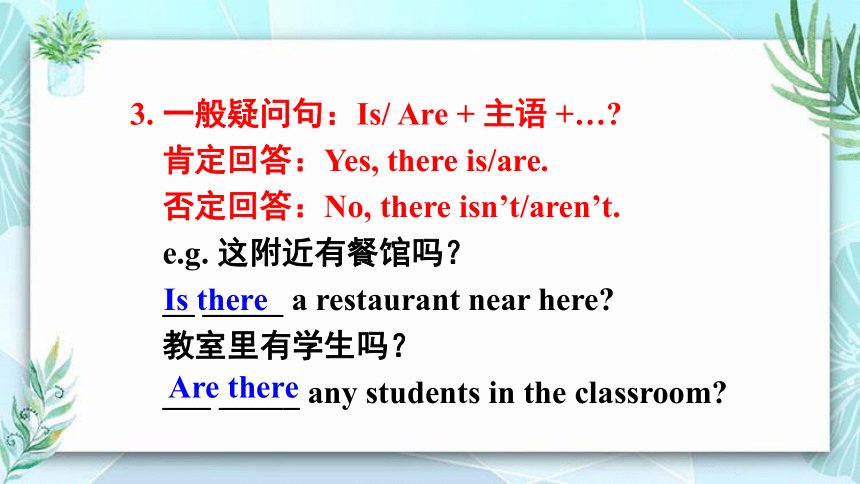
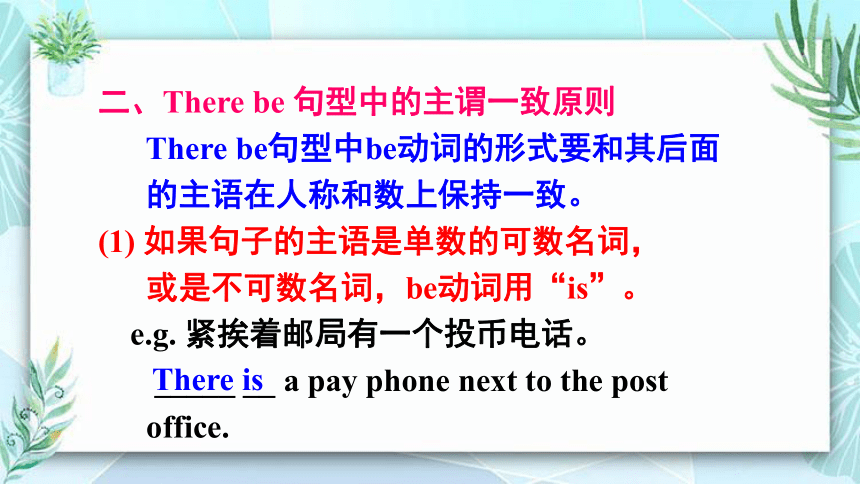
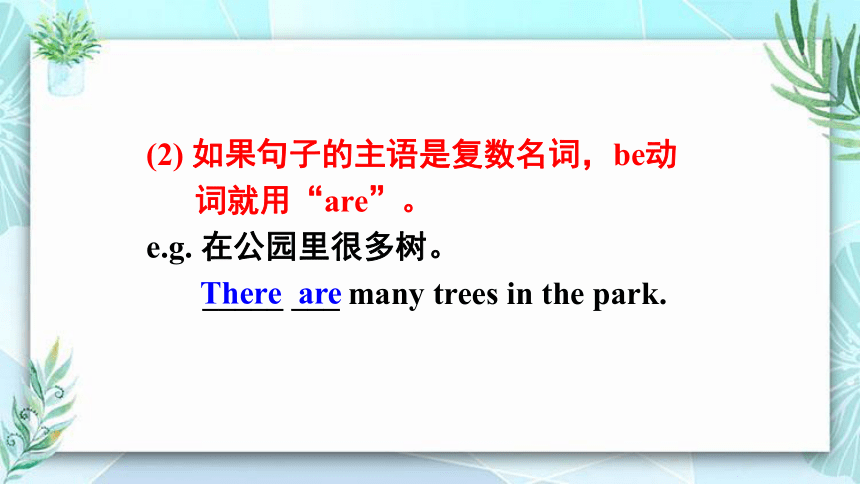
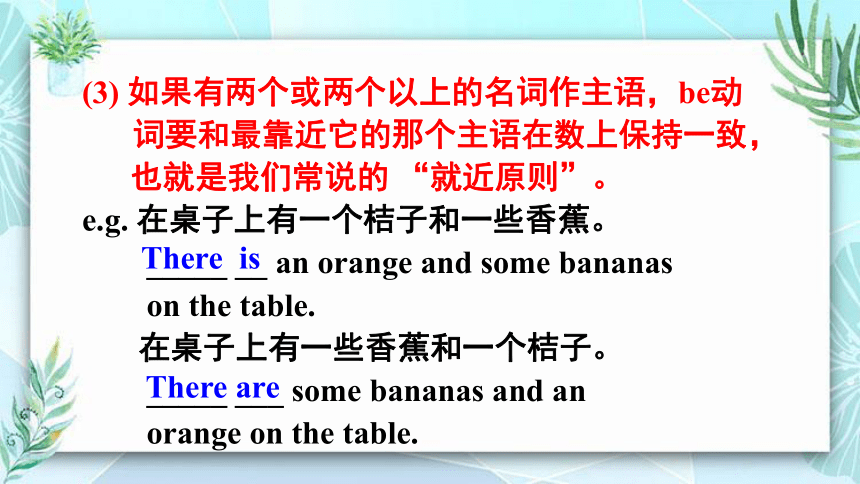
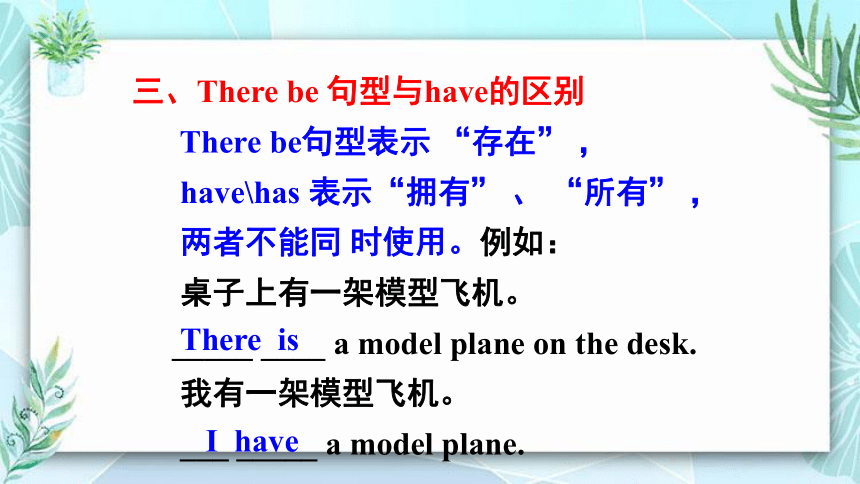

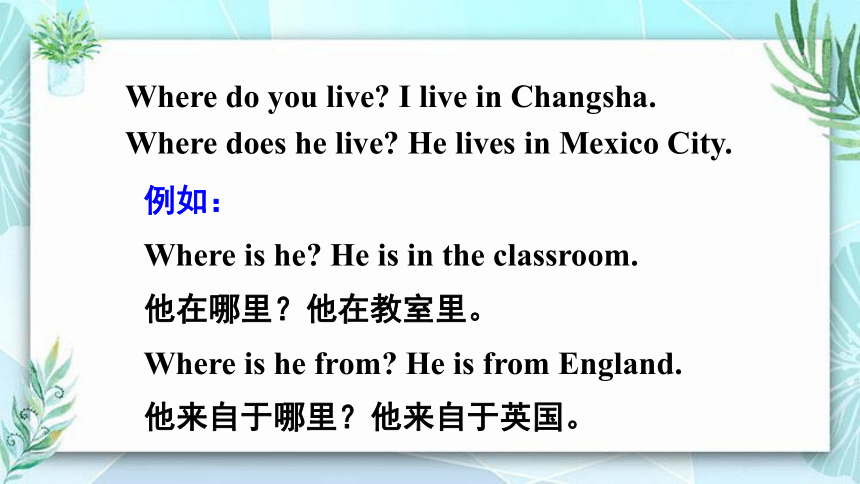
文档简介
(共34张PPT)
Unit 8
Is there a post office
near here
单元知识点复习课件
Asking the Way
Is there a…near here
Where is the nearest…
Can you tell me how I can get to the…
Can you tell me how to get to the…
Could you tell me the way to the…, please
Which is the way to…
Do you know the way to…
Excuse
me.
Showing the Way
Go down/along this street. / Walk along this road.
Take the first turning on the right. /
Turn left at the first turning.
It’s on your right/left. / It’s next to …/across from…
It’ll only take you about 10 minutes if you walk there.
There be 句型
一、There be ...句型表示的是“某处有(存在) 某人或某物” ,其肯定句式结构:
1. There be (is,are) +名词+地点状语
e.g. 在我的铅笔盒里有两块橡皮。
_____ ___ two erasers in my pencil box.
在房子前有一棵大树。
_____ __ a tall tree in front of the house.
There is
There are
2. 否定句:There isn’t / aren’t…
e.g. 大桥街上没有银行。
_____ _____ a bank on Bridge Street.
在教室里没有篮球。
______ _____ any basketballs in the
classroom.
There isn’t
There aren’t
3. 一般疑问句:Is/ Are + 主语 +…
肯定回答:Yes, there is/are.
否定回答:No, there isn’t/aren’t.
e.g. 这附近有餐馆吗?
__ _____ a restaurant near here
教室里有学生吗?
___ _____ any students in the classroom
Is there
Are there
二、There be 句型中的主谓一致原则
There be句型中be动词的形式要和其后面
的主语在人称和数上保持一致。
(1) 如果句子的主语是单数的可数名词,
或是不可数名词,be动词用“is”。
e.g. 紧挨着邮局有一个投币电话。
_____ __ a pay phone next to the post
office.
There is
(2) 如果句子的主语是复数名词,be动
词就用“are”。
e.g. 在公园里很多树。
_____ ___ many trees in the park.
There are
(3) 如果有两个或两个以上的名词作主语,be动
词要和最靠近它的那个主语在数上保持一致,
也就是我们常说的 “就近原则”。
e.g. 在桌子上有一个桔子和一些香蕉。
_____ __ an orange and some bananas
on the table.
在桌子上有一些香蕉和一个桔子。
_____ ___ some bananas and an
orange on the table.
There is
There are
三、There be 句型与have的区别
There be句型表示 “存在” ,
have\has 表示“拥有” 、 “所有” ,
两者不能同 时使用。例如:
桌子上有一架模型飞机。
_____ ____ a model plane on the desk.
我有一架模型飞机。
___ _____ a model plane.
I have
There is
where 引导的特殊疑问句
where是特殊疑问词,含有“哪里, 某地”
的意思。一般用来询问地点。where 引导
疑问句时, 主谓要求倒装,且助动词必须与
后面的主语保持一致。
Where’s the park It’s on Center Street.
Where are the books They are on the desk.
例如:
Where is he He is in the classroom.
他在哪里?他在教室里。
Where is he from He is from England.
他来自于哪里?他来自于英国。
Where do you live I live in Changsha.
Where does he live He lives in Mexico City.
根据划线部分提问。
(1) John is from America.
(2) Lucy is in the office.
解析: (1)是指John 来自于美国。因此用
Where… from进行提问。
(2)是指Lucy在办公室。因此只用where 提问。
答案 (1) Where is John from
(2) Where is Lucy
1.-- Is there a hospital near here
-- Yes, there is.
“附近有医院吗?” “是的,有。”
探究
there be表示“某地存在某物”,其一般
疑问句及回答是:
-- Is/Are there…
-- Yes, there is/are. /No, there isn’t/aren’t.
Language Points
拓展
常用的问路句型:
1) Is there…
2) Can you tell me the way to…
3) Which is the way to…
4) Where is …
5) How can I get to…
2. turn right/left 意为“向右/左拐”;在这里
right和left都是副词,意为“向右;向左”。
e.g. 向左拐,你会找到那家宾馆。
Turn left and you can find that hotel.
3. go along/down … “沿着……走”, down和
along都是介词用法。
e.g. 沿着小河走,公园就在右边。
Walk along/down the river and the park
is on the right.
4. on the right/left 意为“在右面/在左面”
on one’s right/left 意为“在某人的右面/左面”
e.g. 在右面有一家银行。
There is a bank on the right.
沿着这条路走,图书馆就在你的左面。
Walk down this road and the library is on your left.
5. at the first crossing 在第一个十字路口
e.g. 在第二个十字路口向右拐。
Turn right at the second crossing.
6. How can I help you 需要我帮忙吗?
表示向他人伸出援手,主动提出帮助的
意思,此句还可说成:How can I help
you 类似的句子还有:
May I help you
Do you need any help
Is there anything I can help (you) with
What can I do for you
7. The pay phone is in front of the library.
in front of 意为“在……前面”
(在某范围之外)
e.g. There is a girl in front of the bus.
在公交车前有一个女孩。
【辨析】in the front of “在……前面”
(在某范围之内)
e.g. There is a girl in the front of the bus.
在公交车的前面有一个女孩。
8. The pay phone is next to the post office.
next to 意为“紧靠着;紧挨着;贴近”
e.g. The little boy is next to his mother.
小男孩紧挨着他的母亲。
【辨析】next to与near的区别
从空间讲near 只表示“在……附近”;而next to有“紧挨着”之意;next to比near靠的更近。
如:Peter sits next to Mike.
彼特紧挨着迈克坐。
Peter sits near Tom.
彼特坐在汤姆附近。
9. It’s across from the park.
across from 意为“在……对面”
e.g. The bank is across from our school.
银行就在我们学校对面。
【拓展】 across 作介词,意为“从一边
到另一边;横过”。
e.g. Can you swim across the river
你能游过这条河吗?
10. between 介词,表示“在……中间”,
常与and 连接, 构成短语,指在两者之间。
例如:
I sit between Lucy and Lily.
我坐在露西和莉莉中间。
among 是指在三者或三者以上的中间。
例如:
My brother is among those boys.
我哥哥在那群男孩中间。
School Park Zoo
Bridge Street
Supermarket Bank
The supermarket is ______ ______ the bank.
The zoo is ______ _______ the bank.
The park is _________ the school _____ the zoo.
across from
across from
between
and
11. neighborhood 意为“附近;附近地区;
街坊”
e.g. 我的街坊们都很友好。
My neighborhoods are friendly.
in the neighborhood 在附近
e.g. 在附近有一家中国餐馆。
There is a Chinese restaurant in the
neighborhood.
12. To get to the park, you just have to cross
Center Street.
to get to the park 是目的状语前置,此句子
中的just起增强语气的作用,和此处的have to
表示 “只要,仅需”。
13. It is very quiet and I enjoy reading there.
enjoy 表示“从中得到乐趣;欣赏;喜欢”,
后接动词时候,动词用-ing形式,即enjoy
doing…,表示喜欢做某事,享受做某事带来的乐趣。
e.g. I enjoy listening to soft music.
我喜欢听轻柔的音乐。
拓展:enjoy oneself 表示 “玩的高兴,愉快”
e.g. Our classmates enjoy ourselves.
14. Take a walk through the park.
在公园里散散步。
walk在短语中的词性是名词,
take a walk 意为“散步”。through是介词,
意思是“穿过,从……中通过”。
链接: (1) walk在英语中有两种词性,例如:
作名词,take a walk / go for a walk 散步 ;
还可以作动词,walk to school 走路上学。
(2) across/through/over
这三个词都有“穿过,通过”的意思,但
across它着重从某物的表面“横过,穿过,
从一边到另一边”;而through 强调从空间
内的一头纵穿到另一头,意思是“穿过,
从……中通过”, over多指从物体上空通过。
用across和through填空。
Go ______ the bridge.
Light comes in _________ the window.
解析: “穿过桥”是从桥的表面横跨;
“光线透过窗户照进来”强调光从窗户中
通过。
across
through
15. spend 花费(时间、金钱等)。
1) spend + (时间、金钱) + on sth.
e.g. 杰克每天花很多时间做作业。
Jack spends a lot of time on his homework.
2) spend + (时间、金钱) + doing sth.
e.g. 我妹妹每天花很多时间读书。
My sister spends much time reading books.
16. free “免费的”
e.g. 这些书都是免费的。
These books are free.
【拓展】free 空闲的;(反义词)busy
e.g. 格林先生本周不忙。
Mr. Green isn’t busy this week.
或(Mr. Green is free this week.)
17. easily 容易地 (副词)(easy + ly →easily)
e.g. 公共汽车站离这里很近,你能很容易地找到。
The bus stop is not far from here.
You can find it easily.
18. To get there, I usually walk out and
turn right on Bridge Road.
这是英语行文的一种方式,在句子开头用to
do…短语,并用逗号将其与句子的主体部分
隔开,相当于汉语“(若)要做……的话”。
e.g. To listen to world news, please key
in “1”.
若要收听国际新闻,请键入“1” 。
Unit 8
Is there a post office
near here
单元知识点复习课件
Asking the Way
Is there a…near here
Where is the nearest…
Can you tell me how I can get to the…
Can you tell me how to get to the…
Could you tell me the way to the…, please
Which is the way to…
Do you know the way to…
Excuse
me.
Showing the Way
Go down/along this street. / Walk along this road.
Take the first turning on the right. /
Turn left at the first turning.
It’s on your right/left. / It’s next to …/across from…
It’ll only take you about 10 minutes if you walk there.
There be 句型
一、There be ...句型表示的是“某处有(存在) 某人或某物” ,其肯定句式结构:
1. There be (is,are) +名词+地点状语
e.g. 在我的铅笔盒里有两块橡皮。
_____ ___ two erasers in my pencil box.
在房子前有一棵大树。
_____ __ a tall tree in front of the house.
There is
There are
2. 否定句:There isn’t / aren’t…
e.g. 大桥街上没有银行。
_____ _____ a bank on Bridge Street.
在教室里没有篮球。
______ _____ any basketballs in the
classroom.
There isn’t
There aren’t
3. 一般疑问句:Is/ Are + 主语 +…
肯定回答:Yes, there is/are.
否定回答:No, there isn’t/aren’t.
e.g. 这附近有餐馆吗?
__ _____ a restaurant near here
教室里有学生吗?
___ _____ any students in the classroom
Is there
Are there
二、There be 句型中的主谓一致原则
There be句型中be动词的形式要和其后面
的主语在人称和数上保持一致。
(1) 如果句子的主语是单数的可数名词,
或是不可数名词,be动词用“is”。
e.g. 紧挨着邮局有一个投币电话。
_____ __ a pay phone next to the post
office.
There is
(2) 如果句子的主语是复数名词,be动
词就用“are”。
e.g. 在公园里很多树。
_____ ___ many trees in the park.
There are
(3) 如果有两个或两个以上的名词作主语,be动
词要和最靠近它的那个主语在数上保持一致,
也就是我们常说的 “就近原则”。
e.g. 在桌子上有一个桔子和一些香蕉。
_____ __ an orange and some bananas
on the table.
在桌子上有一些香蕉和一个桔子。
_____ ___ some bananas and an
orange on the table.
There is
There are
三、There be 句型与have的区别
There be句型表示 “存在” ,
have\has 表示“拥有” 、 “所有” ,
两者不能同 时使用。例如:
桌子上有一架模型飞机。
_____ ____ a model plane on the desk.
我有一架模型飞机。
___ _____ a model plane.
I have
There is
where 引导的特殊疑问句
where是特殊疑问词,含有“哪里, 某地”
的意思。一般用来询问地点。where 引导
疑问句时, 主谓要求倒装,且助动词必须与
后面的主语保持一致。
Where’s the park It’s on Center Street.
Where are the books They are on the desk.
例如:
Where is he He is in the classroom.
他在哪里?他在教室里。
Where is he from He is from England.
他来自于哪里?他来自于英国。
Where do you live I live in Changsha.
Where does he live He lives in Mexico City.
根据划线部分提问。
(1) John is from America.
(2) Lucy is in the office.
解析: (1)是指John 来自于美国。因此用
Where… from进行提问。
(2)是指Lucy在办公室。因此只用where 提问。
答案 (1) Where is John from
(2) Where is Lucy
1.-- Is there a hospital near here
-- Yes, there is.
“附近有医院吗?” “是的,有。”
探究
there be表示“某地存在某物”,其一般
疑问句及回答是:
-- Is/Are there…
-- Yes, there is/are. /No, there isn’t/aren’t.
Language Points
拓展
常用的问路句型:
1) Is there…
2) Can you tell me the way to…
3) Which is the way to…
4) Where is …
5) How can I get to…
2. turn right/left 意为“向右/左拐”;在这里
right和left都是副词,意为“向右;向左”。
e.g. 向左拐,你会找到那家宾馆。
Turn left and you can find that hotel.
3. go along/down … “沿着……走”, down和
along都是介词用法。
e.g. 沿着小河走,公园就在右边。
Walk along/down the river and the park
is on the right.
4. on the right/left 意为“在右面/在左面”
on one’s right/left 意为“在某人的右面/左面”
e.g. 在右面有一家银行。
There is a bank on the right.
沿着这条路走,图书馆就在你的左面。
Walk down this road and the library is on your left.
5. at the first crossing 在第一个十字路口
e.g. 在第二个十字路口向右拐。
Turn right at the second crossing.
6. How can I help you 需要我帮忙吗?
表示向他人伸出援手,主动提出帮助的
意思,此句还可说成:How can I help
you 类似的句子还有:
May I help you
Do you need any help
Is there anything I can help (you) with
What can I do for you
7. The pay phone is in front of the library.
in front of 意为“在……前面”
(在某范围之外)
e.g. There is a girl in front of the bus.
在公交车前有一个女孩。
【辨析】in the front of “在……前面”
(在某范围之内)
e.g. There is a girl in the front of the bus.
在公交车的前面有一个女孩。
8. The pay phone is next to the post office.
next to 意为“紧靠着;紧挨着;贴近”
e.g. The little boy is next to his mother.
小男孩紧挨着他的母亲。
【辨析】next to与near的区别
从空间讲near 只表示“在……附近”;而next to有“紧挨着”之意;next to比near靠的更近。
如:Peter sits next to Mike.
彼特紧挨着迈克坐。
Peter sits near Tom.
彼特坐在汤姆附近。
9. It’s across from the park.
across from 意为“在……对面”
e.g. The bank is across from our school.
银行就在我们学校对面。
【拓展】 across 作介词,意为“从一边
到另一边;横过”。
e.g. Can you swim across the river
你能游过这条河吗?
10. between 介词,表示“在……中间”,
常与and 连接, 构成短语,指在两者之间。
例如:
I sit between Lucy and Lily.
我坐在露西和莉莉中间。
among 是指在三者或三者以上的中间。
例如:
My brother is among those boys.
我哥哥在那群男孩中间。
School Park Zoo
Bridge Street
Supermarket Bank
The supermarket is ______ ______ the bank.
The zoo is ______ _______ the bank.
The park is _________ the school _____ the zoo.
across from
across from
between
and
11. neighborhood 意为“附近;附近地区;
街坊”
e.g. 我的街坊们都很友好。
My neighborhoods are friendly.
in the neighborhood 在附近
e.g. 在附近有一家中国餐馆。
There is a Chinese restaurant in the
neighborhood.
12. To get to the park, you just have to cross
Center Street.
to get to the park 是目的状语前置,此句子
中的just起增强语气的作用,和此处的have to
表示 “只要,仅需”。
13. It is very quiet and I enjoy reading there.
enjoy 表示“从中得到乐趣;欣赏;喜欢”,
后接动词时候,动词用-ing形式,即enjoy
doing…,表示喜欢做某事,享受做某事带来的乐趣。
e.g. I enjoy listening to soft music.
我喜欢听轻柔的音乐。
拓展:enjoy oneself 表示 “玩的高兴,愉快”
e.g. Our classmates enjoy ourselves.
14. Take a walk through the park.
在公园里散散步。
walk在短语中的词性是名词,
take a walk 意为“散步”。through是介词,
意思是“穿过,从……中通过”。
链接: (1) walk在英语中有两种词性,例如:
作名词,take a walk / go for a walk 散步 ;
还可以作动词,walk to school 走路上学。
(2) across/through/over
这三个词都有“穿过,通过”的意思,但
across它着重从某物的表面“横过,穿过,
从一边到另一边”;而through 强调从空间
内的一头纵穿到另一头,意思是“穿过,
从……中通过”, over多指从物体上空通过。
用across和through填空。
Go ______ the bridge.
Light comes in _________ the window.
解析: “穿过桥”是从桥的表面横跨;
“光线透过窗户照进来”强调光从窗户中
通过。
across
through
15. spend 花费(时间、金钱等)。
1) spend + (时间、金钱) + on sth.
e.g. 杰克每天花很多时间做作业。
Jack spends a lot of time on his homework.
2) spend + (时间、金钱) + doing sth.
e.g. 我妹妹每天花很多时间读书。
My sister spends much time reading books.
16. free “免费的”
e.g. 这些书都是免费的。
These books are free.
【拓展】free 空闲的;(反义词)busy
e.g. 格林先生本周不忙。
Mr. Green isn’t busy this week.
或(Mr. Green is free this week.)
17. easily 容易地 (副词)(easy + ly →easily)
e.g. 公共汽车站离这里很近,你能很容易地找到。
The bus stop is not far from here.
You can find it easily.
18. To get there, I usually walk out and
turn right on Bridge Road.
这是英语行文的一种方式,在句子开头用to
do…短语,并用逗号将其与句子的主体部分
隔开,相当于汉语“(若)要做……的话”。
e.g. To listen to world news, please key
in “1”.
若要收听国际新闻,请键入“1” 。
同课章节目录
- Unit 1 Can you play the guitar?
- Section A
- Section B
- Unit 2 What time do you go to school?
- Section A
- Section B
- Unit 3 How do you get to school?
- Section A
- Section B
- Unit 4 Don't eat in class.
- Section A
- Section B
- Unit 5 Why do you like pandas?
- Section A
- Section B
- Unit 6 I'm watching TV.
- Section A
- Section B
- Review of Units 1-6
- Unit 7 It's raining!
- Section A
- Section B
- Unit 8 Is there a post office near here?
- Section A
- Section B
- Unit 9 What does he look like?
- Section A
- Section B
- Unit 10 I'd like some noodles.
- Section A
- Section B
- Unit 11 How was your school trip?
- Section A
- Section B
- Unit 12 What did you do last weekend?
- Section A
- Section B
